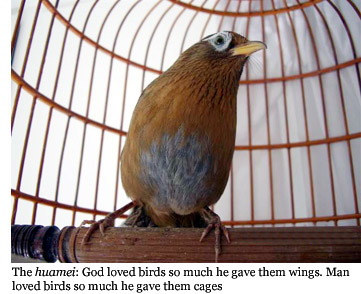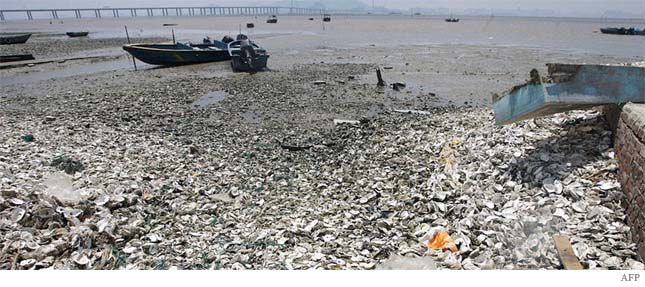Is Western Consumerism Endangering China’s Wildlife?
June 10 – How badly is China’s runaway success affecting its environment? Jonathan Franzen, author of the New Yorker article, “The Way of the Puffin,” travels between Phoenix Arizona and Ningbo on China’s eastern seafront to discover the economic and environmental costs of producing a Puffin golf club cover.
Along the way, he coincidentally comes across a handful of situations that fly in the face of conventional American wisdom over Chinese business practices. Visiting the American company churning out the Puffin – a soft toy producer in Phoenix – he establishes that the supplying company in Ningbo pays their China staff double the going rate. “We want karma in China,” the U.S. managing director says. “And we wanted to pay for perfection.”
Perfection in product they certainly have – at the top end, the furry golf club covers sell to people such as Tiger Woods; the U.S. company provides designs. Showing Franzen several boxes of knockoffs from Chinese manufacturers, the American businessman concludes; “Concerning our design infringements, most of our lawsuits are against American companies. Often the Chinese manufacturers don’t know they’re infringing.”
Once at the factory source in Ningbo, Franzen marvels at the city and the modernity of nearby Shanghai. But herein comes his tale; with Chinese manufacturing growing so fast, what has been the costs to the environment?
Driving across the newly opened Hangzhou Bay Bridge, he notes in a three-hour journey across the bridge and around Ningbo, he only saw three seagulls. Expanding his quest, he hooks up in both Ningbo and Shanghai with local, rather downtrodden, bird watching societies to take him around. Incredibly, he is told that belonging to such an organization can be politically dangerous. People don’t support their activities when it comes to lobbying to preserve natural areas, and it can be considered “socially disruptive.” Non-governmental organizations, such as the Shanghai Wild Bird Society (membership: 200) are not permitted to form alliances with other groups, and officially need a government organization to monitor their activities.
 “Chinese culture prefers caged birds,” says one local. “They can be trained to sing better. A newly captured Huamei (Spectacled Thrush) costs RMB300. A one-year-old can fetch as much as US$2,000. If we want to see birds, we can go to the market.”
“Chinese culture prefers caged birds,” says one local. “They can be trained to sing better. A newly captured Huamei (Spectacled Thrush) costs RMB300. A one-year-old can fetch as much as US$2,000. If we want to see birds, we can go to the market.”
The Huamei is a case in point. A thrush-sized bird, it is remarkable for two things: its head markings, which look like a painted eyebrow (huamei means just that) and its beautiful singing voice. It is one of the iconic birds of China. However, when googling “huamei” and trying to find a reference page about it, no references can be found in the first 40 page entries. Nearly all the rest are given over to a huge assortment of Chinese factories named after the bird, but the bird itself is nowhere to be seen.
Its nearest equivalent in America is the Robin (the bird is found as the first entry “robin” on Google) and the European Mistle Thrush (item three on a Google search).
Franzen, who obviously has a strong interest in ornithology, is dismayed at what he is shown. Even areas set aside as “reserves” are degraded, and infringed upon. Bird life appears minimal. Areas that once teemed with local species have been turned into factory outlets, housing, or other complexes. There is simply no room in the modern China environment for nature.
“It wasn’t always like this,” comments one bedraggled Chinese birdwatcher. “For thousands of years, the Chinese people’s creed was to live in harmony with nature. We hope the recent trend of wealth first is just temporary and then we can get back to our true national beliefs.”
Franzen, sagely, points out the fact that there are two considered points of view when it comes to the commercial and industrial development of a country. Firstly, those societies only start worrying about the environment when they’ve polluted their own land in search of wealth, leisure and entitlement. Second, that this didn’t stop most Western nations from doing exactly that, and the thought of China, India and the rest of emerging Asia and South America doing the same simultaneously is actually a global doomsday scenario.
Wisely, Franzen doesn’t provide a position on the issue, but just brings it to people’s attention. But in doing so, he raises the bar for responsible foreign investment. Would your company absorb costs and wages at double local Chinese rates in order to buy “green” component parts (more expensive) to go into your U.S. / European bound product? On IP issues, how many are actually the result of dubious business ethics of other foreign businesses, rather than Chinese, ripping off designs and trademarks? (Interestingly, of the seven trademark and copyright infringement cases suffered by Dezan Shira & Associates and China Briefing that have involved legal action, only one has been against a Chinese business, all the others have been against American or European consultants). Thirdly, does it matter that China and Asia is losing species?
These are interesting points. It’s also interesting to note that some of the more far-seeing articles on the implications of sourcing and business in China are now filtering down to the concerned. When media such as the New Yorker, and writers such as Jonathan Franzen start to comment – the time for kicking in best socially and environmentally responsible practice standards have arrived. International businessmen, even though China may seem a long way away, may be well advised to note this, and begin to get houses, if dirty in China, in order.
Related articles
China, Top Producer of Greenhouse Gases
Inefficient Coal Plants Shuttered To Reduce Pollution
- Previous Article Businessmen Incarcerated in United States over Chinese Honey Laundering
- Next Article The Hippocratic Oath, China Medical Insurance and Beijing Olympics Medical Care










